Search
Did you mean: Xois?
Search Results
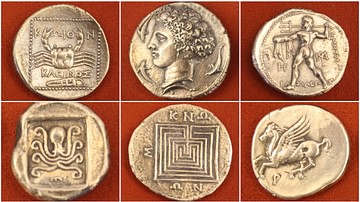
Image
Greek Coins
Top row (L to R): Cos (300-190 BCE) Silver tetradrachm, crab. Syracuse (c. 400 BCE) - Silver decadrachm, head of Arethousa with dolphins. Macedon (306-283 BCE) - Silver tetradrachm, Poseidon with trident. Bottom row (L to R): Euboea...
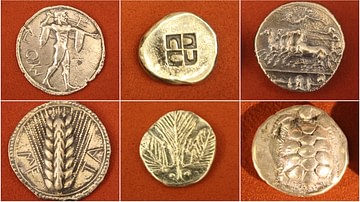
Image
Greek Silver Coins
Top row (L to R): Poseidonia (520 BCE) - Silver stater, Poseidon with trident. Corinth (525-500 BCE) - Silver stater, incuse square of swastika design. Syracuse (c. 400 BCE) - Silver decadrachm, quadriga with Nike crowning a charioteer...
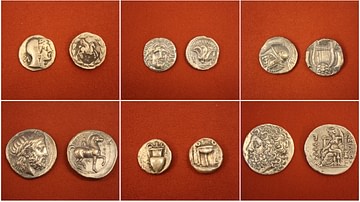
Image
Ancient Greek Silver coins
Top row (L to R): - Silver drachm from Corcyra (Corfu), 229-48 BCE. O: Head of Dione. R: Pegasus. - Silver didrachm from Rhodes, Caria, 304-166 BCE. O: Head of Helios. R: Rose. - Silver stater from Calymna, Caria, 600-550 BCE. O: Male...
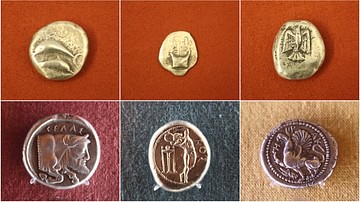
Image
Ancient Greek Coins
Top row (L to R): Thera (c. 500 BCE) - Silver stater, two dolphins. Delos (6th century BCE) - Silver drachm, lyre. Siphnos (540-500 BCE) - Silver stater, eagle. (Alpha Bank Numismatics Museum, Kerkyra, Corfu) Bottom row (L to R...
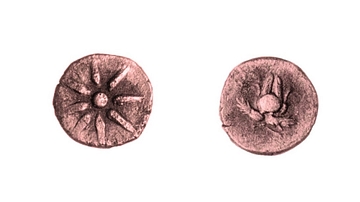
Image
Copper Coins Struck in Vani (Colchis)
Copper. The weights range: hemichalkon – 0,8 gr.-1,1 gr., chalkos – 1,2 gr.-2,1 gr. d=12-13/14-15 mm. for hemichalkon, d=11/13-16 mm. for chalkos. Obverse: Stylized effigy of lotus – Isis’ decoration. Reverse: Eight-pointed star...
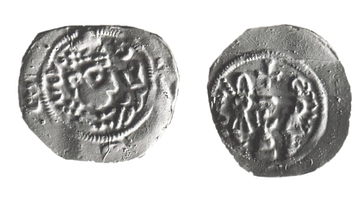
Image
Kartli/Iberia Coins with a Cross & Altar
Silver. The weights range from 2,44 gr. to 3,23 gr. d= 26/27-29/30 mm. Obverse: Ohrmazd IV to the right. Legend in Pehlevi: hrm – aphzu (Ohrmazd Augustus). This is placed within onefold circle of the dots. Reverse: Cross on altar...

Video
Romulus and Remus: a History of a Nation in Coins
This latest AHE video takes a look at how the Roman people represented the myth of Romulus and Remus on their coinage. Spanning in time from 269 BCE- 248 CE.
Ancient History Encyclopedia
www.ancient.eu
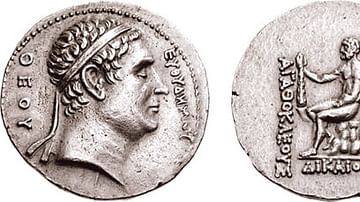
Definition
Coinage
Coins were introduced as a method of payment around the 6th or 5th century BCE. The invention of coins is still shrouded in mystery: According to Herodotus (I, 94), coins were first minted by the Lydians, while Aristotle claims that the first...

Video
Shah Abbas: Coins of faith and power at the British Museum
Vesta Sarkhosh Curtis, British Museum curator of Islamic and Iranian coins, talks through the messaging on some Persian coins.
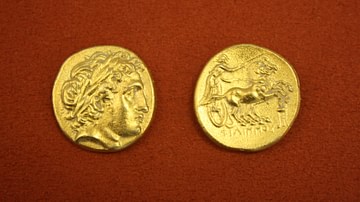
Definition
Numismatics
Numismatics the study of coinage, and is a wonderfully useful tool in the archaeologist's and historian's toolbox. One of the best things for an archaeologist to find while digging is a coin. The reason is simple; it can instantly provide...